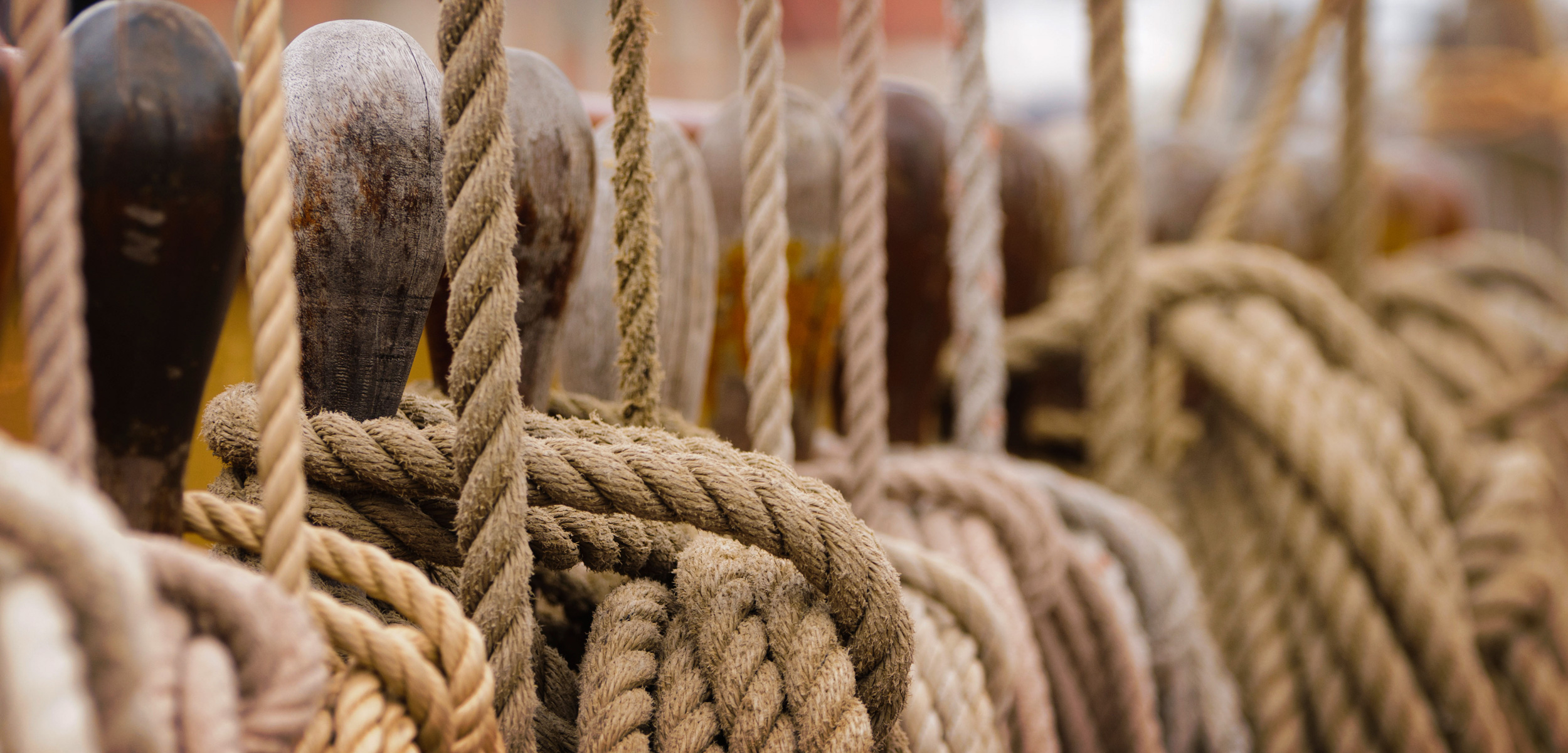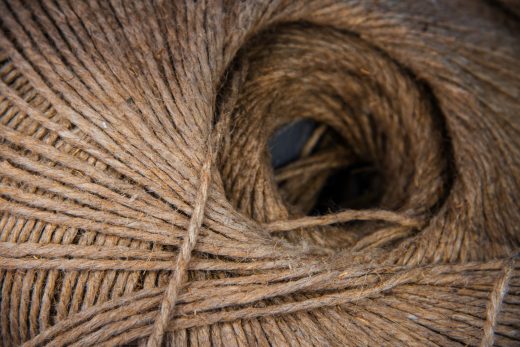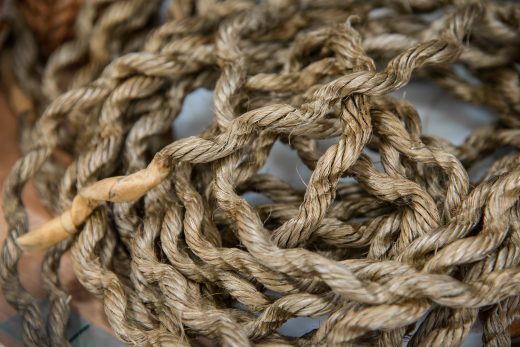The Long, Knotty, World-Spanning Story of String
String is far more important than the wheel in the pantheon of inventions.
Article body copy
The void opened suddenly—a negative space where there had once been sand. Kathryn Bard stuck her hand straight through the gap and felt nothing but air. It just kept going. She considered her surroundings: a slope of windblown sand near a terrace of fossilized coral 700 meters inland from the modern-day Egyptian coast. The recess in front of her, Bard realized, was probably not a result of geological processes; it was too deep. This was something else, something deliberate. Perhaps a tomb. Or a gateway.
Throughout the winter of 2004, Bard, an archaeologist at Boston University, and a team of excavators kept digging through the sand, eventually revealing a cave intentionally carved from fossil coral. Over the next seven years, Bard and an international team of researchers unearthed seven more caves, part of an ancient harbor called Saww, known as Wadi Gawasis today. The ancient Egyptians probably used the caves as shelters and workshops between 2000 and 1750 BCE. Some of the caves contained limestone anchors, timber, steering oars, a bowl, and charred barley seeds. In Cave 5, the researchers discovered a set of particularly stunning artifacts. Not a fleet of intact ships, or protocompasses, or chests of gold and jewels; something much more ordinary, yet indispensable for any seafaring nation—for any civilization.
Bard remembers when she first saw them. She squeezed through a small opening and shuffled sideways through a long narrow passageway to the very back of the cave. There they were: more than 20 thick papyrus ropes, neatly coiled and, by all appearances, so exquisitely preserved it seemed a sailor might come along and scoop them up at any moment. “It was a scene frozen in time,” Bard says. “They hadn’t been disturbed for close to 4,000 years.”
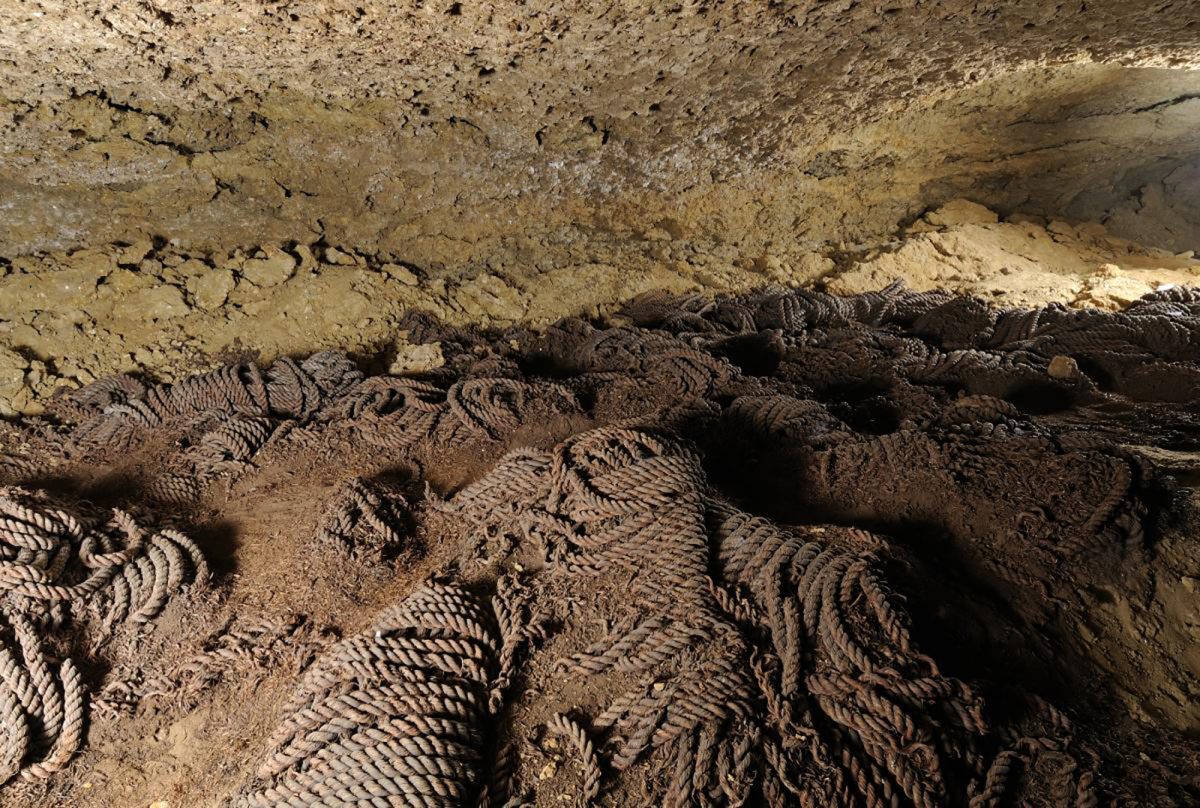
Well-preserved rope was discovered at an archaeological site in Egypt dating to almost 4,000 years ago. Photo courtesy of the Joint Expedition to Mersa/Wadi Gawasis of the Università “L’Orientale,” Naples and Boston University
In his 1956 book The Marlinspike Sailor, marine illustrator Hervey Garrett Smith wrote that rope is “probably the most remarkable product known to mankind.” On its own, a stray thread cannot accomplish much. But when several fibers are twisted into yarn, and yarn into strands, and strands into string or rope, a once feeble thing becomes both strong and flexible—a hybrid material of limitless possibility. A string can cut, choke, and trip; it can also link, bandage, and reel. String makes it possible to sew, to shoot an arrow, to strum a chord. It’s difficult to think of an aspect of human culture that is not laced through with some form of string or rope; it has helped us develop shelter, clothing, agriculture, weaponry, art, mathematics, and oral hygiene. Without string, our ancestors could not have domesticated horses and cattle or efficiently plowed the earth to grow crops. If not for rope, the great stone monuments of the world—Stonehenge, the Pyramids at Giza, the moai of Easter Island—would still be recumbent. In a fiberless world, the age of naval exploration would never have happened; early light bulbs would have lacked suitable filaments; the pendulum would never have inspired advances in physics and timekeeping; and there would be no Golden Gate Bridge, no tennis shoes, no Beethoven’s fifth symphony.
“Everybody knows about fire and the wheel, but string is one of the most powerful tools and really the most overlooked,” says Saskia Wolsak, an ethnobotanist at the University of British Columbia who recently began a PhD on the cultural history of string. “It’s relatively invisible until you start looking for it. Then you see it everywhere.”
Precisely when people began to twine, loop, and knot is unknowable, but we can say with reasonable confidence that string and rope are some of the most ancient materials used by humankind. At first, our ancestors likely harvested nature’s ready-made threads and cordage, such as vines, reeds, grass, and roots. If traditional medicine and existing Indigenous cultures are any clue, early humans may have even used spider silk to catch fish and bandage wounds. Hundreds of thousands, perhaps even millions of years ago, people realized they could extract fibers from the hair and tissues of animals, as well as from the husks, leaves, and innards of certain sinewy, pulpy, or pliant plants, such as agave, cannabis, coconut, cotton, and jute. By twisting these natural fibers around one another again and again, they formed a material of superb resilience and versatility.
There is much evidence—past and present—that we are Homo cordage. Photos by Shanna Baker
Because they are prone to decay, pieces of intact string from more than a few thousand years ago are scarce. Even when they are found, they rarely make headlines or feature in museum exhibits, more likely to be relegated to storage. But they do exist: in 2009, scientists revealed the discovery of tiny 30,000-year-old flax fibers in clay excavated from a cave in Europe. Some of the fibers were twisted, knotted, spun, or dyed turquoise and pink, suggesting complex textiles. If one looks at the archaeological record in the right way—focusing on the implied rather than the material existence of ancient fiber—then the evidence for the importance of string and rope is even older. In South Africa, Israel, and Austria, researchers have found shell and bone beads dating as far back as 300,000 years ago. And in the Hohle Fels cave in southwestern Germany, archaeologists discovered a 40,000-year-old piece of mammoth ivory carved with four holes, each enclosing spiral incisions. They think the tool was used to weave reeds, bark, and roots into a thick cord.
Although string and rope began to take shape on land, it was the ocean that unleashed the full potential of cordage. The earliest watercraft were probably rafts lashed together from branches or bamboo, and dugout canoes carved from logs, such as the 10,000-year-old Pesse canoe discovered in 1955 during motorway construction in the Netherlands. At first, the only means of propulsion were oars, poles, and the whim of the currents. Sailing required a critical insight: that the wind, like a wild animal, could be caught, tamed, and harnessed. A mast and sail, which is really just a tightly knit sheet of string, could trap the wind; long coils of sturdy rope could hoist and pivot the sail. String transformed seagoing vessels from floating lumber to elegant marionettes, animated by the wind and maneuvered by human will.
The exploits of Christopher Columbus, Vasco da Gama, and other European explorers during the age of discovery—all predicated on a mastery of sail—are well known and exhaustively rehearsed. The true history of sail-powered oceanic exploration extends far earlier than the 16th century and far beyond Europe’s shipyards and outposts. Five thousand years ago, the Austronesians began charting and populating the many scattered islands of the Pacific, braving the ocean in double-hulled canoes laden with chickens, fruit, tubers, and firewood. By 2600 BCE, the ancient Egyptians were dispatching sailing ships to Lebanon to gather cedar. Around 1000 CE, Viking explorer Leif Ericsson reached the shores of North America. In 1405, Chinese admiral Zheng He guided a magnificent armada of 317 ships—60 of them boasting multi-tiered decks, nine masts, and 12 sails each, if historical accounts are to be believed—to Southeast Asia and India in pursuit of exotic spices. In the following centuries, after all this precedent, Europe began to churn the oceans with increasing numbers of carracks, caravels, frigates, and galleons.
Terry Schafer, Navy Rigger at Canadian Forces Base Esquimalt, demonstrates how to make a square knot. Video by Shanna Baker
It is no exaggeration to say that from the invention of sailing through the late 18th century, the economic prosperity, scientific progress, and military success of most nations around the globe fundamentally depended on string and rope. For much of this time, there were no major revolutions in sailing technology. Instead, there were elaborations and restructurings of an ancient template: a roughly crescent wooden vessel equipped with at least one mast and sail, and webbed with plenty of rigging. Toward the end of the age of sail, some of the more ostentatious designs verged on the absurd; certain full-rigged ships were so bedecked with line and linen that they looked more like parade floats than instruments of trade and war.
By the late 1700s, engineers in England, France, Scotland, and North America were experimenting with steamboats. In 1822, the Aaron Manby became the first iron steamship to go to sea, traveling across the English Channel from London to Paris. By the 1860s, the British, French, and Russian navies had heavily armed steamships. After this, “a great epoch in naval history came to an end,” write Romola and R. C. Anderson in The Sailing Ship: Six Thousand Years of History.
But it was not the end of the line for cordage. Even today’s motorized metal behemoths, slicing through the sea at unprecedented speeds, rely on rope and string. Terry Schafer, a navy shipyard rigger in Victoria, British Columbia, has been professionally tangled with cordage since the 1980s. “When I finished my apprenticeship, I worried I had chosen a dying craft,” he says. “But there is still a lot of demand for a skilled rigger today.” Schafer and his colleagues manufacture all the cordage the navy requires: tow ropes; hoist cables for cranes, winches, and dumbwaiters; woven fenders that cloak the lips of tugboats like mustaches and beards; ropes to tie the ships at harbor; ropes that fly the navy’s flags; and artfully knotted ropes to ring the bells that help sailors keep strict schedules. Schafer mostly works with synthetic materials including Kevlar, various plastics, and metal wire. But he occasionally uses plant fibers as well: cotton, flax, manila hemp (from a species of banana), sisal (from agave), and coir (from the waterproof buoyant husks of coconuts).
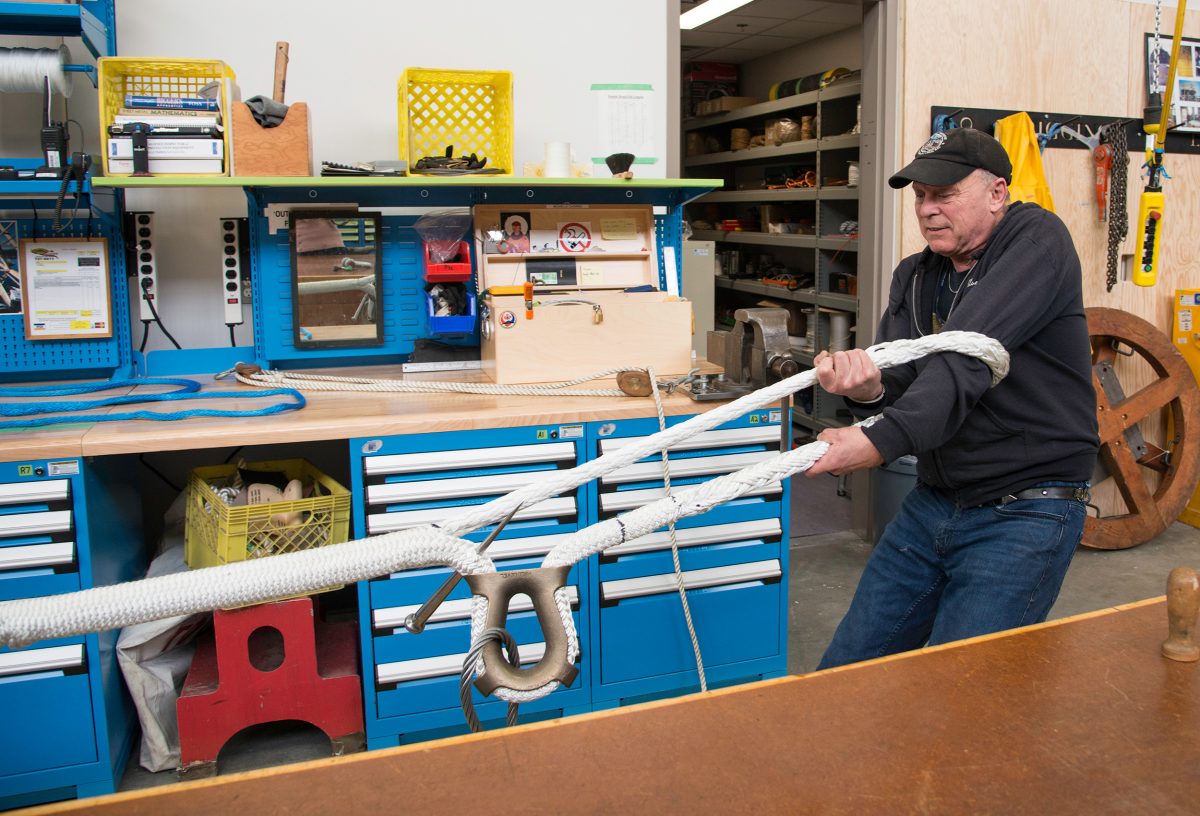
There is still a need for professional riggers like Terry Schafer, who works in the Canadian navy shipyard in Victoria, British Columbia. Photo by Shanna Baker
In the course of his work, Schafer occasionally refers to The Ashley Book of Knots, an encyclopedic illustrated guide to more than 3,500 practical and decorative knots with names like fisherman’s bend, cowboy’s pretzel, false lover’s, and wild goose. Written by American artist and sailor Clifford Ashley and first published in 1944, the book is a bible for professional rope workers and knot enthusiasts of all kinds. If any among them can claim to be Ashley’s successor, it is probably Des Pawson, a 71-year-old bespectacled and thickly bearded knot guru in Ipswich, England. Since 1989, Pawson and his wife, Liz, have earned their livelihood by making and selling boat fenders, bell ropes, hammocks, mats, belts, lanyards, theatrical props, and all manner of spliced and knotted handiwork to boatbuilders, retail outlets, gift shop suppliers, film producers, and various other clients. In Ipswich, Pawson curates the world’s only museum devoted entirely to knots and sailors’ rope-work. He is also a cofounder of the International Guild of Knot Tyers, an association of more than 1,000 knot connoisseurs that meets several times a year and has, throughout its 36-year history, attracted scholars, sailors, surgeons, farmers, miners, and magicians.
“Cordage is an everyday material, and because it’s so everyday people don’t understand its value,” Pawson says. “But if it was taken away, you’d notice. Rope and knots are the building blocks of civilization. They pervade all aspects of our world.”
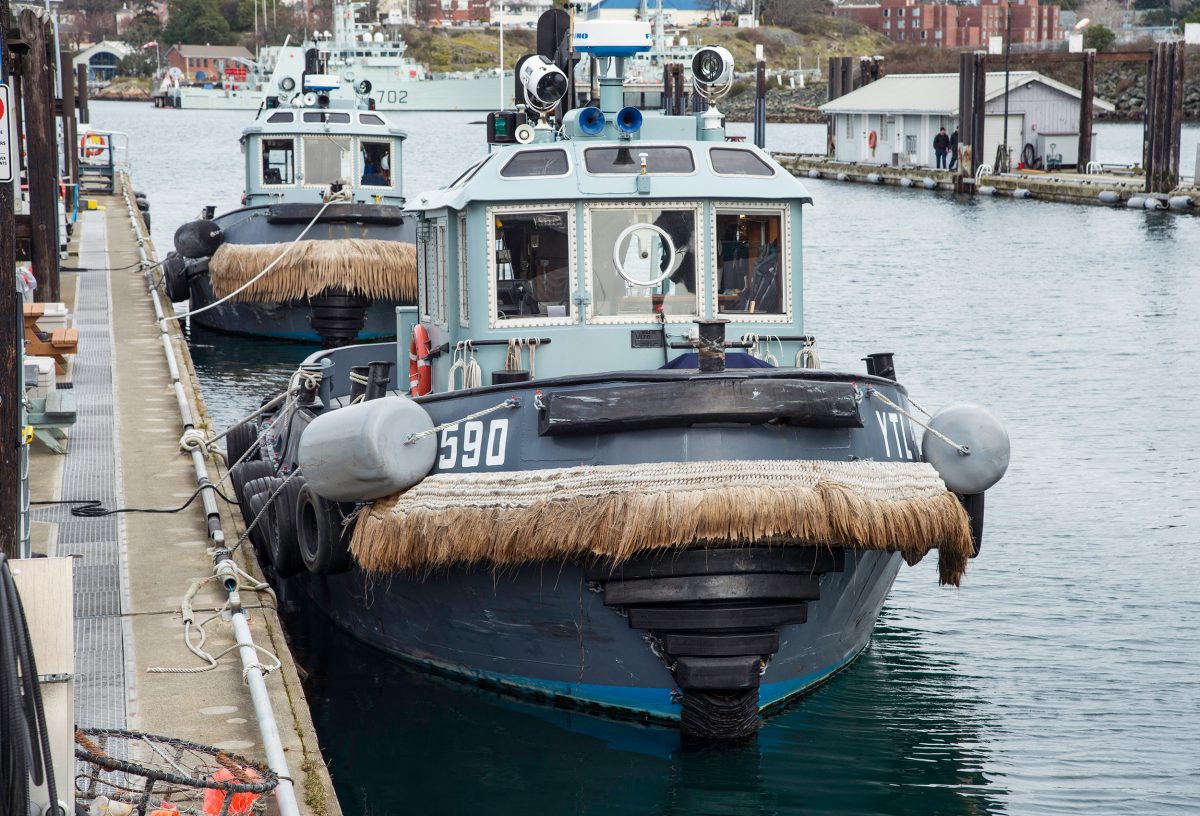
Naval riggers weave all sorts of necessary tools: cables for cranes, ropes that fly the navy’s flags, and fenders for tugboats, above. Photo by Shanna Baker
Look around. We still wear shoes laced with string. Our clothes, sheets, curtains, carpets, and tablecloths are all woven from thread. Our phones, computers, toasters, blenders, and TVs still largely depend on bundles of wire transporting electrons. Above our heads, power lines, phone lines, and fiber-optic cables sling from one utility pole to another. More than a million kilometers of undersea cables tie the continents together—the submerged ligaments of global telecommunications. When a nuclear submarine docks at a harbor, no matter how massive and intimidating, it still needs some rope to serve as moorings. Despite all the astounding advances in medicine in the past few centuries, surgeons still require needle and thread. Cordage is so invaluable that it has even accompanied our most sophisticated scientific machinery into the depths of space: to secure cables on the Mars rover Curiosity, NASA engineers relied on variations of the clove hitch and reef knot, two traditional knots that have been used for thousands of years. That rover is currently exploring the surface of Mars.
String changed much more than human technology; it also altered our psychology. More than a physical material of enduring versatility, string has retained immense symbolic significance in many cultures around the world. For the Indigenous peoples of the Andes, string was its own mathematical language. From at least 1400 to 1532 CE, they recorded taxes, census data, and other numerical information with quipu: sequences of colorful tassels made from cotton and camelid hair, all dangling from a central cord, and each knotted in its own way. String and rope are stitched into the English language, into longstanding idioms—learn the ropes, spin a yarn, hang by a thread—and even in the way we talk about relatively modern inventions: to describe the internet, we speak of websites, links, and threads. Cordage also features prominently in myths and folk tales. According to a popular Sudanese myth, a rope once united heaven and Earth, until a mischievous hyena severed it, ushering death into the world. In Greek mythology, the three Moirai, or Fates, spin, measure, and cut threads representing every mortal’s life. And various myths originating in Asia tell of the Red String of Fate, an invisible red fiber, a capillary of the soul, linking the ankles or fingers of kindred spirits, future couples, or those simply fated to cross paths.
Naval rigger Terry Schafer demonstrates how to make a sheet bend. Video by Shanna Baker
If you visit Ise, Japan, when the tide is high, you can see one of the most romantic tributes to the symbolic power of string. Just off the coast, two rocks sit side by side, separated by the ocean, but joined by thick straw ropes. Known as meoto iwa (rock couple), they represent the union of the Izanagi and Izanami, the deities that created the Japanese archipelago. Their wedding bands, woven by local villagers, are shimenawa, plaited ropes of rice straw often used to mark sacred sites in the Shinto religion. Because the ropes are continually exposed to wind and surf, they are prone to decay. So, three times a year, at low tide, villagers dressed in white robes march into the sea with ladders, remove the old salt-soaked bonds, and replace them with fresh straw rope. A version of this ritual has been practiced for at least 200 years, possibly much longer.
The long-lived tradition attempts to defy the inevitable. The sun and sea and wind will never stop assailing the stoic couple. The elements do not condone this marriage. But therein lies the ultimate lesson of string: even in a bafflingly complex and indifferent universe tumbling inescapably toward complete dissolution, it is still possible to weave composite strength from the small and solitary, to purposefully anchor one thing to another—to tie a knot.

